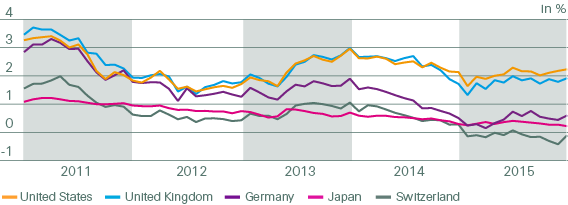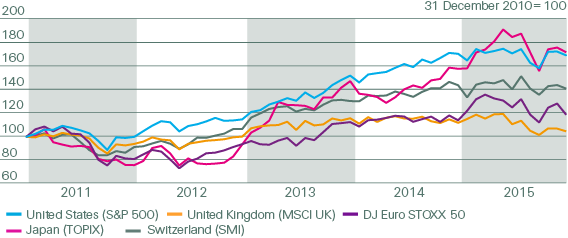Market environment
Amid challenging conditions we had a strong performance in 2015, delivering a strong net income of USD 4.6 billion and setting a path for the future by updating our strategic framework.
Global growth improved in 2015 but developed unevenly across regions. The US economy grew at a solid pace, while growth in China slowed. Monetary policies of major central banks remained accommodative and government bond yields were low. Equity markets performed moderately in the first half of the year and declined in the second half.
The global economy and financial markets
The US and UK economies continued to expand at a solid pace, driven by investments and robust consumer spending. In contrast, the recovery in the Eurozone remained weak. While low interest rates, low oil prices and a relatively weak euro contributed to the Eurozone’s highest growth since 2011, its growth rate was still about one percentage point below the US and the UK. Among the Eurozone’s southern and other peripheral countries, Ireland and Spain experienced the strongest expansion, while recovery was sluggish in Italy and especially in Greece. Unemployment in the Eurozone decreased slightly but remained significantly above the pre-crisis level. The Japanese economy grew modestly with the Bank of Japan (BoJ) continuing its quantitative easing programme. Falling commodity prices, fears of a Chinese hard landing and the expectation of monetary tightening in the US created uncertainty for the global economy.
Headline inflation fell in many countries due to lower oil prices. In the US, the Eurozone and the UK, it dropped close to zero. However, core inflation, which excludes food and energy prices, was basically unchanged in the US at 1.8%. Inflation in Japan also dropped below 1% after rising to 2.8% in 2014 due to the sales tax increase in April 2014.
Economic performance in emerging markets was disappointing overall but varied across regions. China’s economic growth in 2015 fell almost one-half percentage point below the level of 2014, driven by lower exports and modest investment growth. India’s performance was stronger, with business and consumer sentiment improving significantly on expectations of a strong push towards economic reform and liberalisation. India was the world’s fastest-expanding large economy in 2015.
Growth in Latin America was disappointing with deep recessions in Brazil and Venezuela and below-trend growth in the rest of the region. Brazil’s economy contracted by more than 3%, suffering from lower consumer spending and a large drop in investments. The Mexican economy was hampered by low industrial activity and falling oil and gas production while private consumption remained healthy. In Southeast Asia, economic activity was robust, with strong growth in the Philippines, Malaysia and Vietnam. In contrast, Russia’s economy fell into a deep recession due mainly to low oil prices and sanctions.
Major economies in Africa and the Middle East developed unevenly, driven largely by political developments and lower oil and commodity prices. Growth in South Africa was sluggish, as companies dealt not only with lower commodity prices but also with weak domestic and foreign demand, electrical outages, union actions and rising input costs. Saudi Arabia experienced solid growth, though the central government’s fiscal balance deteriorated sharply due to lower oil prices.
2.3%
US 10-year treasury bond yield
1.5%
Eurozone real GDP growth, 2015 (est.)
Interest rates
The monetary policies of the major central banks remained accommodative, but diverged according to their different economic growth rates. The European Central Bank (ECB) and the BoJ continued their quantitative easing programmes as Eurozone and Japanese economies were still fragile and deflation remained a risk. In contrast, the US Federal Reserve Board (the US Fed) moved towards monetary policy normalisation and finally increased the target range for the federal funds rate in December.
Market expectations for the interest rate hike kept yields for US and UK ten-year government bonds about 1.5 percentage points above German and Japanese bond yields. Despite the start of monetary policy normalisation in the US, interest rates remained historically low in the advanced economies (including the US).
In an attempt to contain inflation and to stop the depreciation of the real, Brazil increased its interest rate to double digits, while China and India both reduced rates.
Interest rates for ten-year government bonds 2011–2015

Source: Datastream
Stock market performance
Global stock market performance was mixed: the US S&P 500 was down 1%, the Swiss Market Index 2% and the MSCI UK 6%. The Japanese TOPIX was up 8% and the Euro Stoxx 50 4% (see stock markets chart). After three years in which major markets ended in positive territory, equity market development slowed down due to increased uncertainty, weak profit growth and investors caution.
Investor risk aversion was driven by concerns of reform fatigue in the Eurozone, instability in Iraq and Syria and uncertainties about the effect, especially on emerging markets, of the interest rate hike by the US Fed. Investors were also concerned about declining growth prospects in China and the sluggish growth of global trade.
Stock markets 2011–2015

Source: Datastream
Currency movements
The ECB’s announcement of a quantitative easing programme and fears about the stability of the Eurozone caused the euro to depreciate against the US dollar and other major currencies during the first quarter of the year. The Swiss franc appreciated strongly after the Swiss National Bank (SNB) removed the exchange rate floor of 1.20 francs per euro in January. Against the background of slower growth, persistent pressure on the export industry and the divergence between spot and forward exchange rates, the People’s Bank of China (PBoC) devalued the Chinese renminbi to around 6.4 per US dollar in August, surprising the markets. Against the US dollar, the renminbi, euro, pound and Swiss franc ended the year down 4%, 10%, 6% and 1% respectively, while the yen remained unchanged.
Economic risks affecting re/insurers
Many risks could derail global growth and adversely impact financial markets and re/insurers.
Concerns remain about the effect of US monetary policy normalisation on emerging markets. In recent years, their economies have been supported by rapid credit growth (especially in the private sector) due to inexpensive and abundant domestic and external liquidity. Higher interest rates in the US and a subsequent reduction in global liquidity now may lead to further capital outflows. In addition emerging market debt is often denominated in US dollars rather than in local currencies. A further appreciation of the US dollar would therefore cause the debt ratios of many countries to increase.
One of the major concerns for the global economy stems from a pronounced slowdown in Chinese economic growth. Investment could also drop sharply if China’s debt markets were disrupted by large defaults. This ‘hard landing’ scenario would put further pressure on commodity prices and global trade.
The risks for Europe are manifold. The threat of a Greek debt default could flare up again. Coupled with the contagion risk to other Eurozone members, this could put European leaders in the dilemma of taking unpopular actions to avoid the collapse of the euro. Europe also awaits the UK referendum on the EU membership to be held on 23 June 2016. In addition, instability in Syria and Iraq is likely to remain a serious challenge, with corresponding heightened concerns over migration and terrorism.
These risks would affect re/insurers mainly via adverse asset price movements and slower growth potential in the affected markets. In addition, a “flight to quality” could lead to a drop in interest rates and exacerbate the challenges from the current low yield environment.
| Download |
|
USA |
Eurozone |
UK |
Japan |
China |
|||||||||||||
|
2014 |
2015 |
2014 |
2015 |
2014 |
2015 |
2014 |
2015 |
2014 |
2015 |
||||||||
|
||||||||||||||||||
Real GDP growth1 |
2.4 |
2.4 |
0.9 |
1.5 |
2.9 |
2.2 |
–0.1 |
0.7 |
7.4 |
6.9 |
||||||||
Inflation1 |
1.6 |
0.1 |
0.4 |
0.0 |
1.5 |
0.0 |
2.8 |
0.8 |
2.0 |
1.4 |
||||||||
Long-term interest rate2 |
2.2 |
2.3 |
0.5 |
0.6 |
1.8 |
2.0 |
0.3 |
0.3 |
3.7 |
2.9 |
||||||||
USD exchange rate2,3 |
– |
– |
121 |
109 |
156 |
147 |
0.83 |
0.83 |
16.1 |
15.4 |
||||||||